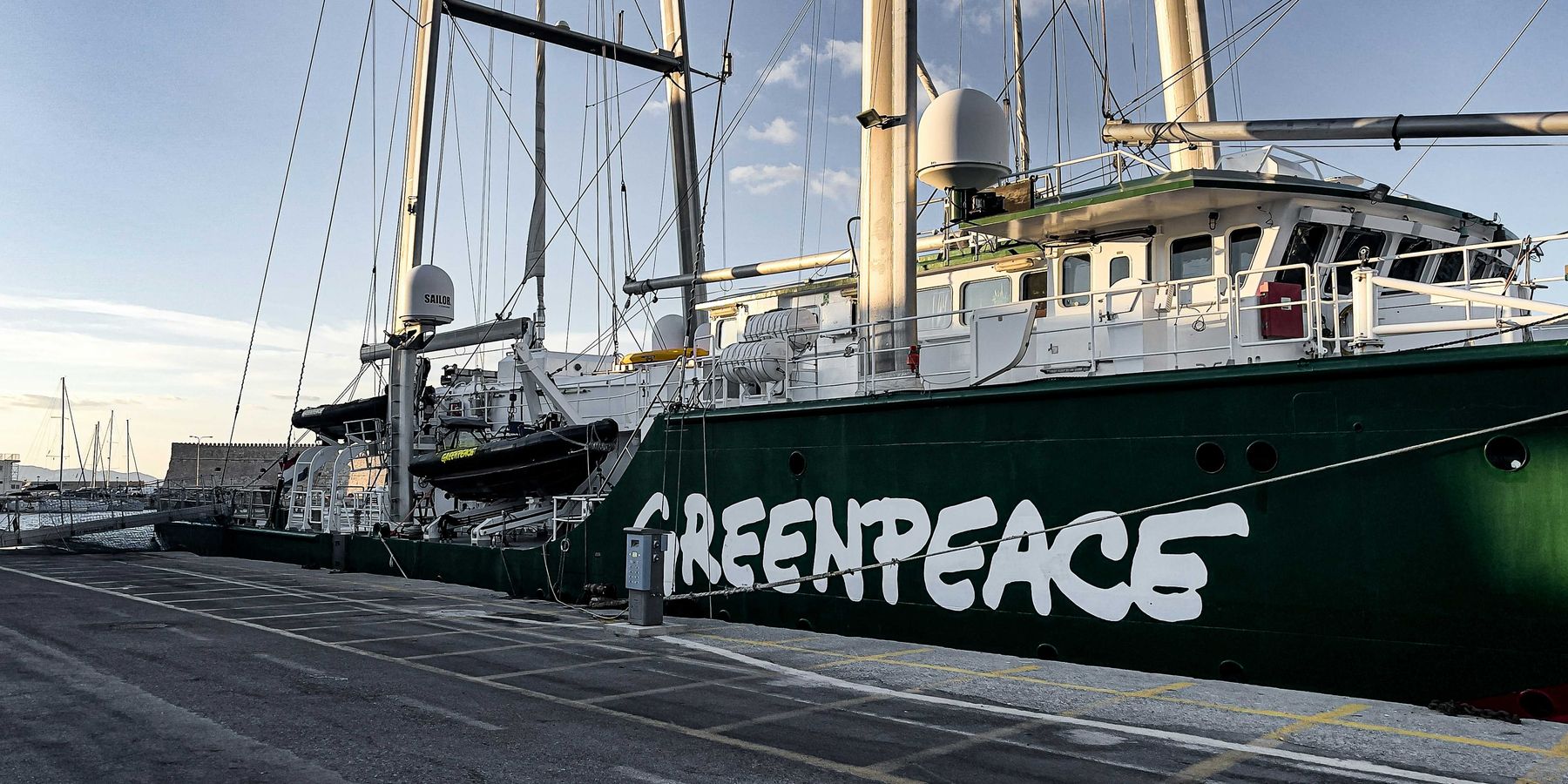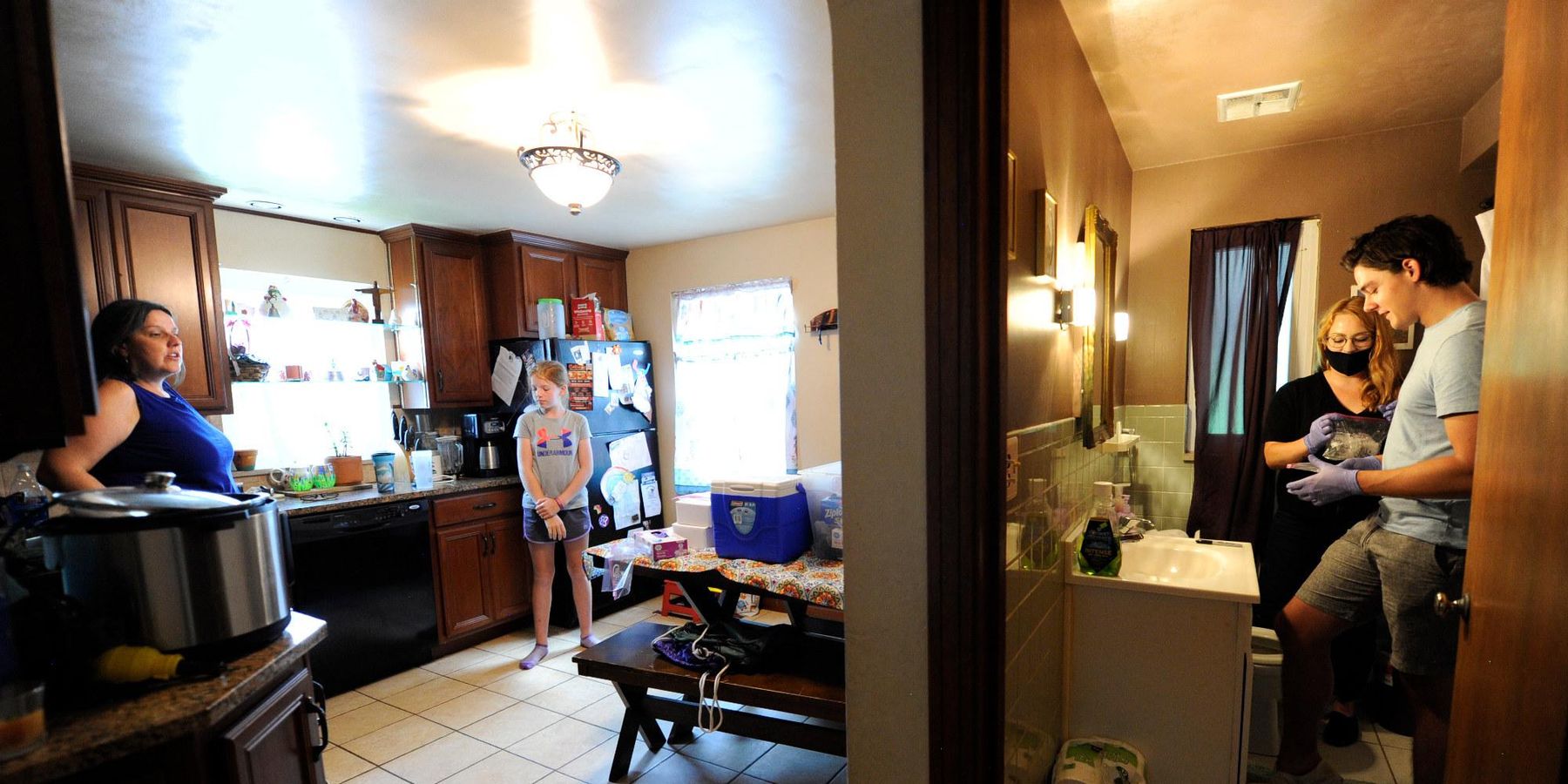
Fractured: Buffered from fracking but still battling pollution
A statewide network of fracking and conventional wells, pipelines, and petrochemical plants closes in on communities.
This is part 4 of our 4-part series, "Fractured," an investigation of fracking chemicals in the air, water, and people of western Pennsylvania.
WESTMORELAND COUNTY, Pa.—On a balmy evening in September of 2019, eight women gathered around a conference table in a small office about 25 miles southeast of Pittsburgh.
Sunlight streamed through large windows, casting a warm glow over a side table set with coffee, biodegradable cutlery, and three kinds of pie.
"Eat pie, ladies," commanded a tall, middle-aged woman with silver-streaked hair.
As a mother of four and the outreach coordinator for the nonprofit organization hosting this event, Ann LeCuyer was comfortable telling people what to do. She'd spent the last four years helping the group, Protect PT* (short for Protect Penn-Trafford), work to keep fracking out of the small municipalities of Penn Township, Trafford, and surrounding neighborhoods.
In that time, Ann and her boss, Protect PT co-founder and executive director Gillian Graber, had compiled thousands of documents detailing the oil and gas industry's plans in the region. They'd invited all of the group's several dozen members to their office to learn how to access them—but only women showed up.
"This is pretty typical for us, actually" said Gillian, a middle-aged mom of two with chocolate-brown hair and a no-nonsense demeanor.

Protect PT's Project and Outreach Coordinator Ann LeCuyer (center) and Executive Director Gillian Graber (right), both of Trafford. (Credit: Connor Mulvaney for Environmental Health News)
"I think it's because we're moms, so we have more at stake when it comes to our children and grandchildren," she told Environmental Health News (EHN), noting that every member in attendance had kids and half also had grandkids. "My husband is on the board and we do have some very passionate male members. But it tends to be the women who consistently show up."
The group chattered and laughed through the presentation until Ann pulled up a map of the planned route for the Mariner East 2 Pipeline, sending a brief hush through the room.
"It's so close to my house!" someone exclaimed. "Look, I'm in the blast zone and I didn't even know until now."
Mariner East 2 is one of three pipelines (along with Mariner East 1 and Mariner East 2X) being constructed to carry highly flammable natural gas liquids—liquid components of natural gas that have been separated out—350 miles from the Utica and Marcellus Shale plays in eastern Ohio, the northern panhandle of West Virginia, and across Pennsylvania to processing facilities at Philadelphia ports. From there, the end products will be carried overseas by ship for use in plastics production. (Ethane, a byproduct of fracking, is used to manufacture plastics.)
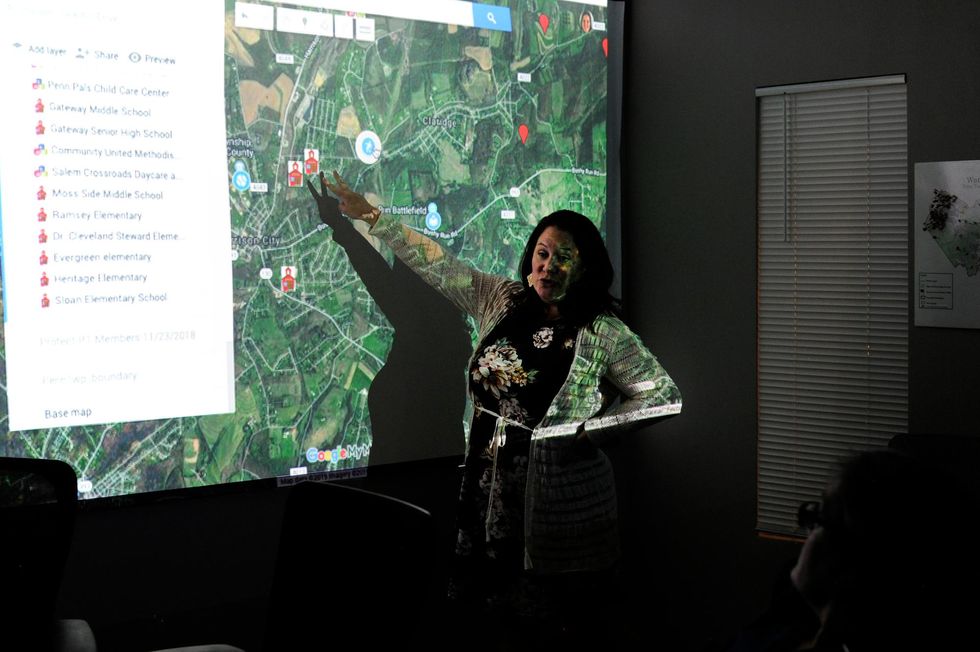
Executive Director of Protect PT Gillian Graber of Trafford explains a map of community and natural gas infrastructure to Protect PT members during an event at the non-profit's Harrison City, Pennsylvania, headquarters. (Credit: Connor Mulvaney for Environmental Health News)
The project is orchestrated by Sunoco's parent company Energy Transfer LP, which also owns the controversial Dakota Access Pipeline. The Mariner East pipeline projects have been rife with accidents, spills, and controversy, in part because Pennsylvania doesn't have a state agency that oversees the placement of such pipelines. The planned route runs across people's yards and within a half mile of 23 public schools and 17 private schools, which worries residents due to the company's safety record: Between 2002 and the end of 2017, Energy Transfer LP pipelines experienced a leak or an accident every 11 days on average.
Pipeline construction in Pennsylvania has already resulted in sinkholes, polluted waterways on public land, and an explosion in a town 35 miles west of Pittsburgh that destroyed a house. At least 25 other sites along the proposed pipeline route have been identified as being at risk for similar accidents. The Pennsylvania Utility Commission is fighting in court to keep its calculations on potential damage if such accidents occured secret, even though a recent investigation by Spotlight PA found many communities in the "blast zone"—the areas adjacent to the pipeline that could be engulfed in flames in the event of a pipeline explosion—lack adequate emergency response plans.
Gillian told the group that they planned to canvas in the blast zone nearby to inform residents they'd be at risk if the pipeline is completed.
"Oh, we're canvassing, ladies!" chirped the oldest of the group, a spry 81-year-old. "If we can stop the pipeline, we can stop the well pads. I'm getting my muckboots out!"

Members of Protect PT, a nonprofit focused on educating community members and elected officials on unconventional natural gas development, gather in their Harrison City, Pennsylvania, headquarters. (Credit: Connor Mulvaney for Environmental Health News)
Gillian initially started Protect PT in 2015 because she wanted to stop a fracking well proposal about a quarter of a mile from her house in neighboring Penn Township. So far, her efforts have been successful—the well, which is owned by Apex Energy, received a permit from the Pennsylvania Department of Environmental Protection (DEP) in 2018, but has yet to be drilled in part because of Protect PT lawsuits.
But that fracking well victory is overshadowed by a vast industrial infrastructure in the state and the region that goes well beyond unconventional drilling.
In the summer of 2019, EHN collected air, water, and urine samples from five households in southwestern Pennsylvania, including Ann and Gillian's families, and had them analyzed for chemicals associated with fracking. EHN included Ann and Gillian's families because they live further away from fracking wells than the families we looked at in Washington County. However, despite their relative distance from fracking wells, we found they also faced above average levels of exposure to numerous chemicals associated with pollution from the oil and gas industry.
While Project PT and similar groups target new pipelines, or plastics plants, or fracking wells in court—or just the court of public opinion—it has become a game of whack-a-mole in a state where oil and gas production, infrastructure, and transportation are so ubiquitous.
"It's just alarming to think that with all the stuff that we're doing to be careful, we're still being exposed to all these chemicals," Gillian told EHN.
A rocky market

Executive Director of Protect PT Gillian Graber of Trafford at an event at the non-profit's Harrison City, Pennsylvania, headquarters. (Credit: Connor Mulvaney for Environmental Health News)
Grassroots groups like Ann and Gillian's across the country have scored some big wins against pipeline projects in recent years, in part because opposition to them is so widespread.
Even state lawmakers who believe their communities support fracking say they've heard pipeline complaints.
"I don't think I've had a complaint about the [fracking] industry in a year—what I've heard has all been positive," Republican Pennsylvania Senator Gene Yaw, who chairs the state Senate Environmental Resources and Energy Committee, told EHN. "I hear complaints about the Mariner East Pipeline near Philadelphia all the time, but that's not in my district." He added that in his district, there have been no issues with the company building the pipeline.
Emily Smith, a spokesperson for the American Petroleum Institute, pointed to her organization's comprehensive pipeline safety recommendations and told EHN the pipeline industry has "made a number of commitments to move towards their goal of zero incidents, from using the latest technologies, to creating recommended practices with regulators and forming industry work groups to sharing best practices."
While construction of Mariner East pipelines is still underway, a number of other massive pipeline projects have recently been canceled. These include Dominion Energy and Duke Energy's Atlantic Coast Pipeline, which would have carried natural gas from the Marcellus Shale to Virginia and the Carolinas, and Williams Cos Inc's Constitution Pipeline, which would have carried gas from Pennsylvania to New York.
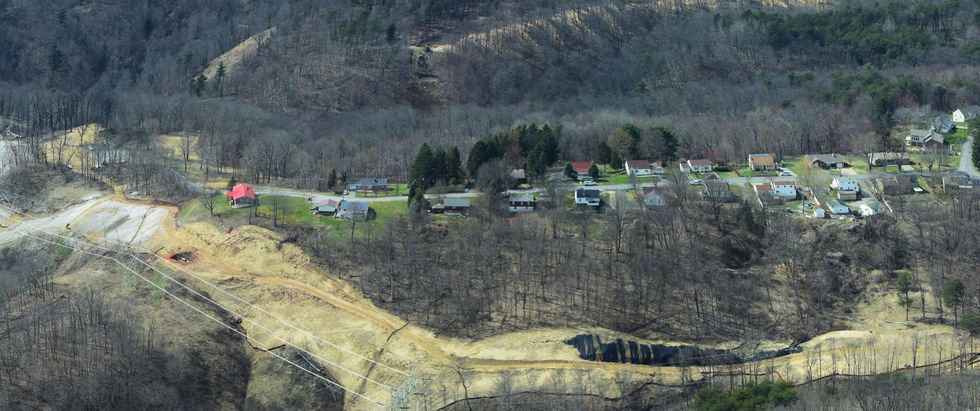
Aerial view of blackened trees at the site of a 2018 explosion of the ETC Northeast Revolution Pipeline in Center Township, Pennsylvania. (Credit: Ted Auch, FracTracker Alliance, 2019)
This is in part due to public pressure, but it's also a response to market demands.
The pandemic has devastated the industry by driving global oil prices to historic lows. But before the pandemic, the fracking industry had already seen a massive downturn: Between 2012 and 2017, the 30 biggest fracking companies lost a combined $50 billion. Fracking is expensive and many companies go into a tremendous amount of debt to get started. Due to oversupply and consistently low prices for natural gas over the last 10 years, many have yet to pay those debts back and become profitable.
"This is a mature industry in long-term decline," Kathy Hipple, a financial analyst at the Institute for Energy Economics and Financial Analysis (IEEFA), told EHN, adding that these market conditions are also causing a slowdown in the construction of pipelines.
"In addition to public pressure, the utilities that build these pipelines are seeing that they're not operating at capacity so there's no economic need to justify the build," she explained. "Sometimes industry says 'we must, we must, we must,' but when they actually have an updated needs-analysis done, they realize demand has flattened due to efficiencies, or supply by renewables, or both."
Others remain confident the market will bounce back.
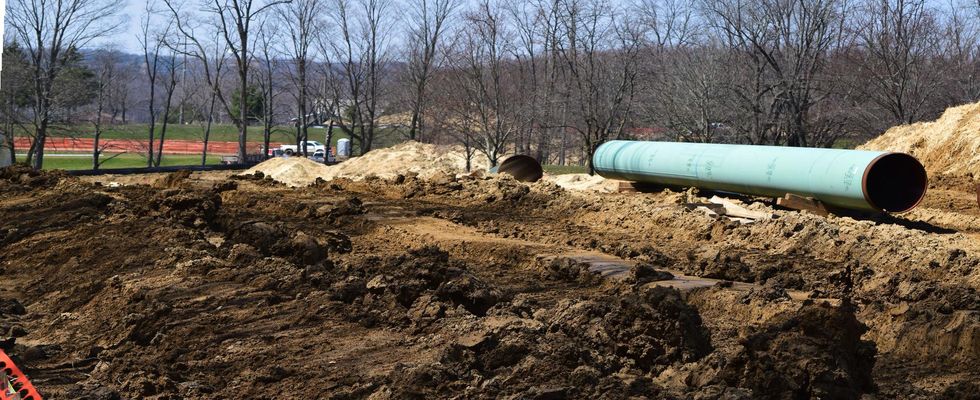
Natural gas pipeline construction in Medina, Ohio. (Credit: Ted Auch, FracTracker Alliance, 2018)
"Obviously COVID has been a shock to all different types of industries—airlines, restaurants and travel have all been affected, and we have too," Kathleen Sgamma, president of the Western Energy Alliance, an industry group representing 200 unconventional oil and gas companies that operate in the Western U.S., told EHN. "Eventually we're all going to stop living in our basements and return to normal life, and global oil demand will recover as people go back to work and traveling and normal life."
Market conditions could remain rocky or bounce back as community groups like Protect PT wage battles against the Goliaths of the oil and gas industry one project at a time. But in places where oil and gas has a strong presence, its reach is already expansive.
Between a densely interwoven network of pipelines, conventional oil and gas wells, fracking wells and related infrastructure, and ongoing petrochemical development by dozens of companies, it has become virtually impossible to escape the environmental health impacts of the oil and gas industry in places like western Pennsylvania.
"The issue is, it's not just one facility or one pipeline," Matt Mehalik, executive director of the Breathe Project, a coalition of 46 environmental organizations in the Pittsburgh region, told EHN. "This is an entire network of polluting facilities that pose risks to our water and air that is rapidly expanding throughout the region, and we don't have good oversight of the impacts of their combined emissions."
“Shocking” exposures
Gillian Graber lives with her husband Ryan and two children Aidan and Lilly in a two-story brick house in a quiet cul-de-sac full of homes built in the '60s and '70s. Two narrow, one-way streets separated by a grass median go into and out of the neighborhood, and the parallel rows of houses are flanked by woods on either side.
Their home is in Trafford, a small neighborhood about 17 miles east of Pittsburgh. Most of the 1.4 square mile borough is in Westmoreland County with a tiny section extending into Allegheny County. According to the most recent Census, Trafford is home to 3,039 people. There are no fracking wells within Trafford's borders.
The Grabers moved to Trafford in 2013 from Churchill, a suburb closer to Pittsburgh, when Aidan, now 12 years old, was about to start kindergarten. Lilly, who is now 10 years old, was a rambunctious 3-year-old at the time. They moved because they liked the school district and lower property taxes, and it still felt close enough to the city to visit. There was a playground and an ice cream shop within walking distance, and unlike the busy, four-lane road they lived on at their old place, Ryan told EHN, "this house was on a road where you could teach a kid how to ride a bike."

Ryan, Aiden, Lilly and Gillian Graber sit at the kitchen table in their Trafford, Pennsylvania, home. (Credit: Connor Mulvaney for Environmental Health News)

Ryan Graber in his Trafford, Pennsylvania, home. (Credit: Connor Mulvaney for Environmental Health News)
When they were searching for homes, they found some affordable ones in Plum, another suburb of Pittsburgh, where they also liked the school district—but they realized the discount was due to the home's proximity to a coal-fired power plant and they worried about air quality. "Trafford seemed to be a good place that had clean air," Ryan said.
Ann, her husband Mike, and their four children, who were ages 8,10, 12, and 14 in the summer of 2019, live in a small two-story brick home on a quiet residential street about two miles from Gillian's house. It's a ten-minute walk from the local elementary school, which Ann and Gillian's kids attend. They have a chicken coop in the backyard and a shaggy rescue dog named Gandalf. They moved here from Plum in 2016 because they liked the kid-friendly neighborhood—wide sidewalks, lots of young families, a park nearby.
When Ann and Gillian learned that EHN wanted to study households near fracking and compare them to households further away from well pads, they jumped at the chance to participate. At Protect PT they'd already spent months collecting baseline air quality and noise data in the region so that if fracking wells did eventually come, they'd be able to document how things changed.
The nearest active fracking well is about seven miles away from Gillian's house. The nearest compressor station is about five miles away. Compressor stations pressurize and compress natural gas to keep it moving through long distance pipelines, and their emissions are linked to higher mortality rates. Ann lives about a mile further than Gillian does from both sites. EHN was seeking families living at least five miles from the nearest well or compressor station in order to compare them with families closer to fracking activity.
While many of the most shocking outliers from our project occurred within the families that are surrounded by fracking infrastructure within two miles of their homes in Washington County, we were surprised by what we found in Ann and Gillian's families.
We collected a total of 12 urine samples from Gillian's family and 15 urine samples from Ann's family over a 4-week period and found 21 chemicals in one or more samples, including benzene, toluene, naphthalene, xylenes, other volatile organic compounds (VOCs), and lesser-known compounds, all of which are linked to health problems.
Some chemical exposures aren't detectable in urine if the body has already broken them down, so we also looked for breakdown products, or biomarkers, for harmful chemicals. Some of these biomarkers show up when people consume certain foods or beverages, so to determine whether the levels we saw in Pennsylvania families were normal, we compared them against those seen in the average American using U.S. Centers for Disease Control and Prevention's (CDC's) National Health and Nutrition Examination Survey.
Read about how we conducted our study

Ann LeCuyer and her children. (Credit: Connor Mulvaney for Environmental Health News)
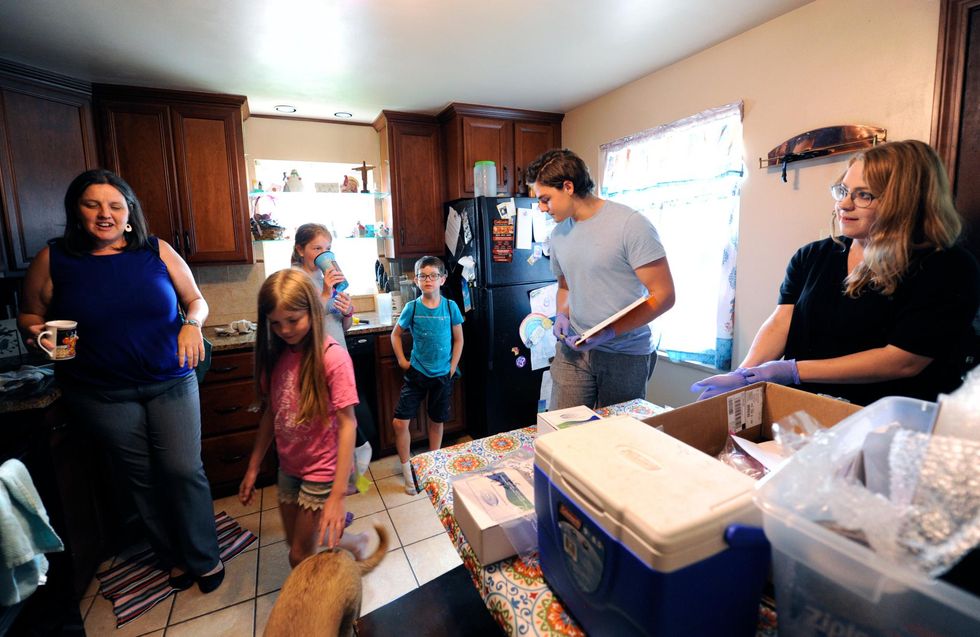
EHN reporter Kristina Marusic (right) and Southwest Pennsylvania Environmental Health Project intern Mason Secreti (middle-right) prepare to collect urine samples from the LeCuyer-Ley family. (Credit: Connor Mulvaney for Environmental Health News)
We found that urine samples for both families also contained biomarkers of other fracking chemicals at levels higher than the U.S. 95th percentile—the value that 95 percent of Americans fall below, according to CDC data.
All samples from both families exceeded the U.S 95th percentile for mandelic acid, a biomarker for ethylbenzene and styrene, and 87 percent of Ann's family's samples exceeded the U.S. 95th percentile for phenylglyoxylic acid, another biomarker for ethylbenzene and styrene. More than half of Ann's family's samples exceeded the U.S. 95th percentile for trans, trans-muconic acid, a biomarker for benzene.
Exposure to ethylbenzene, styrene, and benzene is linked to negative health effects including skin and eye irritation, central nervous system damage, and increased cancer risk.
On August 21, 2019, Gillian's daughter Lilly, who was 9-years old at the time, had the highest level of 3-methylhippuric acid, a biomarker for xylene, detected in anyone in our study. Xylene exposure is linked to skin, eye, and respiratory tract irritation, drowsiness and dizziness, and organ damage with high levels of long-term exposure.
"It's pretty shocking to know that our children, especially, are being exposed to this stuff," Gillian told EHN. "We take great pains to make sure we're not exposed to things."
Gillian and Ryan try to buy organic foods when they can. They avoid contaminants like bisphenol-A (BPA) in plastic and Teflon in cookware, and they installed a reverse osmosis filter at the kitchen tap to make their drinking water as clean as possible. They avoid using cleaning or pest control products with harsh chemicals.

The Graber family in their living room. (Credit: Kristina Marusic for Environmental Health News)
Some concerning chemicals showed up in the familys' air and water samples, too.
In Gillian's water, we found detectable levels of 14 of the 40 chemicals we analyzed the samples for, including benzene, toluene, and naphthalene. In Ann's water, we found detectable levels of 11 of the 40 chemicals we analyzed the samples for. That list also includes benzene, toluene, and naphthalene. Most of the chemicals we looked for are unregulated, so there is no legal limit for them in drinking water. There are federal limits for benzene, toluene, ethylbenzene, m/p-xylenes, and styrene in drinking water. None of the levels we found in Gillian and Ann's water exceeded those limits, but experts say being exposed to any level of these chemicals can be harmful.
"Regardless of what the regulatory levels are for a particular chemical, you can often find a study out there that shows health effects at lower levels," Chris Kassotis, an endocrine toxicologist and assistant professor at Wayne State University's Institute of Environmental Health Sciences, told EHN. "In the U.S., experience tells us that just because something meets regulatory limits doesn't necessarily mean it's safe."
Both families get their water from Wilkinsburg-Penn Joint Water Authority, which serves around 40,000 Pennsylvanians and is the fifth largest water authority in the state.
"These levels were so small they didn't surprise me," Mark Lerch, the director of supply at Wilkinsburg-Penn Joint Water Authority, told EHN. "We test for much more than what's required of us by law."
Some of these families' air samples showed the highest levels of exposure to certain compounds seen in our study. On August 15, 2019, the five highest levels of both d-limonene and styrene detected in our study were detected in air monitoring samples from the five members of the LeCuyer-Ley household. On the same day, Ann's husband Mike's air monitor also detected the highest level of toluene seen in our study.
On the same day, Gillian's husband Ryan's air monitor detected the highest levels of 1,2,3-trimethylbenzene, o-diethylbenzene, undecane, m/p-diethylbenzene, decane, and 1,2,4,5-tetramethylbenzene seen in our study.
Only a handful of these chemicals have regulatory limits, most of which pertain to short-term workplace exposures. Ann and Gillian's families' air samples exceeded one regulatory threshold for three chemicals—the recommended limits on benzene, ethylbenzene, and naphthalene exposure set by the California Office of Environmental Health Hazard Assessment to minimize cancer risk.
"I was just shocked to see that my family had the highest numbers of anybody for some of this testing," Ann said. "I knew the air was bad in southwestern Pennsylvania, but it's more concrete to have tests done that show that you're being exposed."
“Airsheds don’t respect geopolitical boundaries”
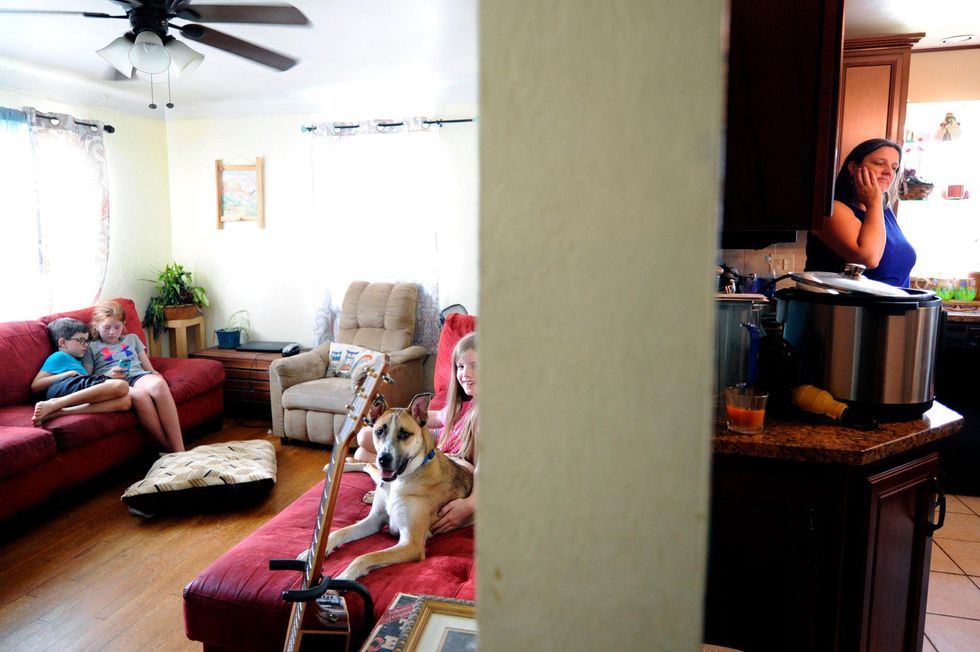
LeCuyer family. (Credit: Connor Mulvaney for Environmental Health News)
There are a number of potential reasons for these above-average exposures. As with the other families, their results could reflect exposures from spending time in traffic, pumping gas, or exposures to diesel fumes, cigarette smoke, paint, or off-gassing carpets or furniture.
Another reason could be the notoriously poor air quality associated with vehicle emissions and other types of industrial pollution that plagues southwestern Pennsylvania in general, and neighboring Allegheny County in particular.
The region is home to the Clairton Coke Works, the largest coke battery in the country. Coke batteries are special ovens that heat coal to extremely high temperatures to convert it into coke, which is used to manufacture steel. Emissions from such plants include a carcinogenic mix of chemicals, some of which are similar to emissions from fracking wells. There are very few of these facilities remaining in the country, and an earlier EHN analysis revealed that the average level of exposure to coke oven emissions for residents of Allegheny County is 99 percent higher than it is for the U.S. population as a whole.
"Winds from the northwest will take air pollution from the Clairton Coke Works and blow it into Westmoreland County," Mehalik told EHN. "Particles can travel very long distances."
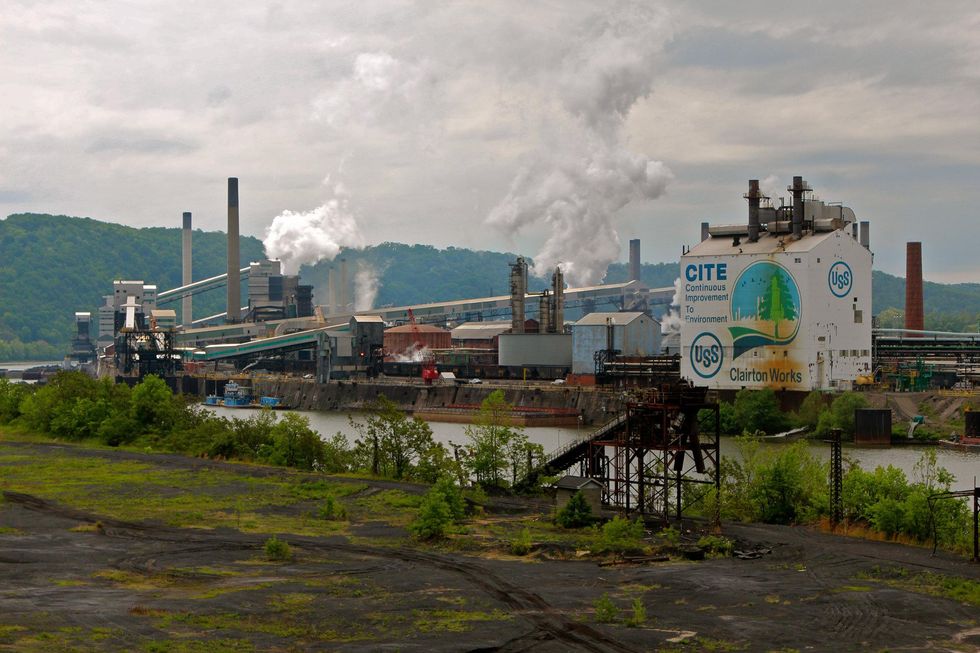
Clairton Coke Works. (Credit: (Roy Luck/flickr)
John Graham, a senior scientist at the Clean Air Task Force said that air pollution modeling supports the idea that Westmoreland County sees greater air quality impacts from emission sources near Pittsburgh than Washington County does. He looked at the U.S. Environmental Protection Agency's (EPA's) National Air Toxics Assessment (NATA), which estimates cancer risk from air pollution in each census tract using emission data.
"This shows that the impact on average is 64 percent greater in Westmoreland than in Washington County," Graham told EHN. "That suggests there is absolutely a health risk in the adjacent counties from emissions originating in Allegheny County. Very roughly, if the impact on average to people in Allegheny Co. is 1, it's just under half that to people in Westmoreland County, and just over 1/4 of the impact in Washington County."
In addition to pollution blowing over from neighboring Allegheny County, Westmoreland County has its own smaller coke works, ArcelorMittal Monessen (for now, at least), about 23 miles south of Trafford. The plant is one of at least 21 industrial sites in the county emitting enough air pollution to require a Title V permit—the type required under the U.S. Clean Air Act for the highest-volume air polluters in the country. Washington County, which is slightly smaller in both size and population, has just eight Title V permits. (Allegheny County, by comparison, has at least 28 such permits in an area nearly 300 square miles smaller with a population more than three times larger than Westmoreland County).

Lilly Graber at a 2019 youth climate change protest in downtown Pittsburgh. (Credit: Connor Mulvaney for Environmental Health News)
According to the most recent available NATA data from 2014, estimated cancer risk from air pollution overall is higher in Westmoreland County than in Washington County, but estimated cancer risk specifically from the oil and gas industry is higher in Washington County.
A third potential source of exposure is the fracking wells and compressor stations within 10 miles of Ann and Gillian's homes. Emissions are most concentrated in areas closest to wells, but some studies have found that depending on wind patterns and geography, they may impact communities much further downwind. One study published in May of 2020 documented negative changes in air quality as far as six miles downwind of fracking wells; another study led by Harvard researchers that was published in October of 2020 found increased levels of radiation up to 31 miles downwind of fracking sites.
Finally, both the women's homes are surrounded by a high volume of conventional oil and gas wells. There are at least 100 conventional wells within five miles of both Ann and Gillian's homes. Under Pennsylvania law, conventional wells can be within 200 feet of an occupied building in the state, compared to 500 feet for unconventional wells.

Gillian Graber gets set up with an air monitor in her kitchen. (Credit: Connor Mulvaney for Environmental Health News)
Research suggests that people living near conventional wells may face similar exposures to people near fracking wells. They may also be just as under-regulated, if not more: A 2018 investigation by the environmental advocacy group Earthworks found severe leaks at conventional wells in Allegheny National Forest, and conventional wells in Pennsylvania had nearly twice the number of violations seen in unconventional wells in 2019 according to the DEP's 2019 oil and gas report.
"Airsheds don't follow geopolitical boundaries," Alison Steele, executive director of the Southwest Pennsylvania Environmental Health Project*, told EHN. "We've run into issues with communities that have a concern about a facility that's not located in their municipality or even in their county… They don't have much recourse since elected officials there aren't beholden to them."
The exposures we found in Gillian and Ann's families show that fracking is one of many sources of emissions from polluting industries in this region. Everyone in the region—and well beyond—is impacted by air pollution.
Pennsylvania is the fourth-largest greenhouse gas emitter in the U.S. It's not a coincidence that the state also has the third highest cancer incidence rate of all U.S. states. Approximately half of all Pennsylvanians will be diagnosed with cancer at some point in their lifetime, and roughly one in five Pennsylvanians dies of cancer. Cancer is the second-leading cause of death in the state.
"If you want to live in the state of Pennsylvania, there's literally nowhere you can go where you won't be exposed to something," Gillian said. "In an urban environment like Pittsburgh it's industrial and traffic emissions, and in rural areas it's oil and gas."
“I just don’t know if it’s in the cards for us to go anywhere else”

Ann LeCuyer and her kids look in on the family's chicken coop. (Credit: Connor Mulvaney for Environmental Health News)
The stories we heard from people living among fracking wells in southwestern Pennsylvania aren't unique. In similar communities across the country, people struggle with many of the same issues: Physical and mental health symptoms, worry over the long-term impacts of chemical exposures, feeling abandoned by regulators and mistrustful of the fracking companies being left to self-regulate, grieving the industrialization of formerly idyllic countrysides, and feeling alienated and ostracized in communities divided over whether fracking is a boon or a burden.
But the exposures EHN documented in the 20 people in our study suggest that southwestern Pennsylvanians are experiencing higher-than-average levels of harmful pollution—even compared to other fracking communities.
Very few other studies have investigated whether these chemicals are getting into the bodies of people who live near oil and gas operations, but among those that have, our results stand out.

Gillian Graber with her children, Aidan and Lilly. (Credit: Connor Mulvaney for Environmental Health News)
A 2018 study of 29 pregnant women who live near fracking wells in Canada found trans, trans-muconic acid, a biomarker of benzene, at levels around 3.5 times as high as those seen in the general Candadian population. The median level of trans, trans-muconic acid seen in people in that study was 180 micrograms per gram (µg/g) of creatinine (a substance measured to account for different metabolic rates when looking at biomarkers). The median for the U.S. as a whole, according to CDC data, is 77 µg/g. The median level seen in our study was 484 µg/g—nearly three times as high as the level seen in the Canadian study.
"l saw that the levels of trans, trans-muconic acid you saw in your study were quite a bit higher than what we found," Élyse Caron-Beaudoin, an assistant professor at the University of Toronto Scarborough and the lead author of the Canadian study, told EHN after reviewing our findings. "And we certainly thought the levels seen in our study were quite high."
A 2016 study in Pavillion, Wyoming tested urine samples for 11 farmers who live near fracking wells and found elevated levels of biomarkers for many of the same chemicals we looked for—but in most cases, the levels we detected in Pennsylvania were significantly higher.
The median levels we detected for 8 of the 11 biomarkers we looked for were higher in Pennsylvania than those seen in the Wyoming study; the maximum levels we detected were higher for 7 out of 11 compounds. In many cases the gaps were substantial.
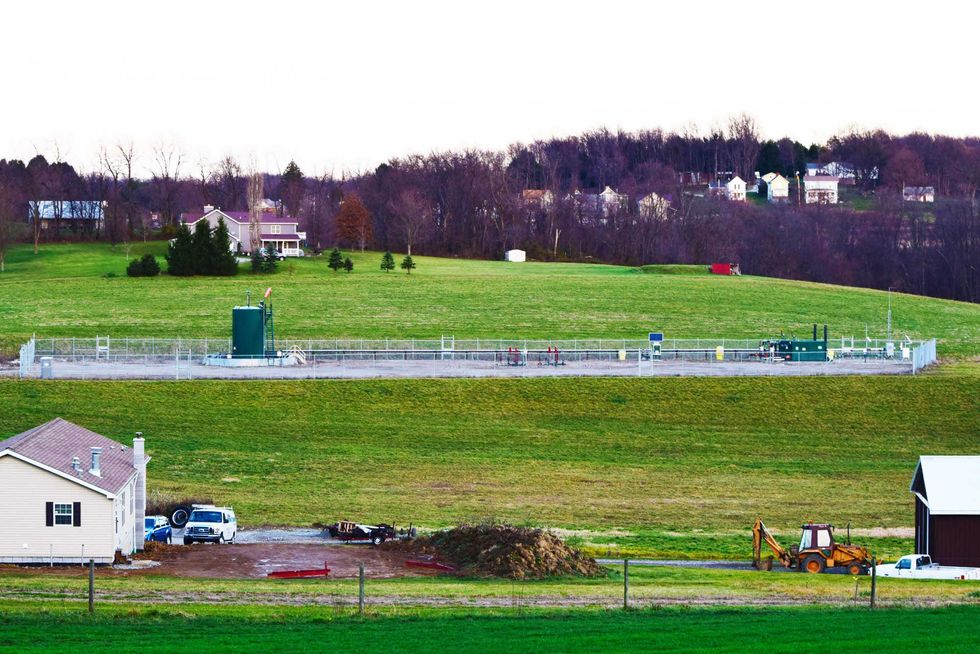
A fracking well pad between homes in western Pennsylvania. (Credit: Ted Auch, FracTracker Alliance, 2015)
For example, the median level of mandelic acid seen in the Wyoming study was nearly twice as high as the national average according to CDC data, while the median level we detected in Pennsylvania residents was more than 10 times as high as the level seen in the Wyoming study. Mandelic acid is a biomarker for ethylbenzene and styrene.
"In general, biomonitoring studies like this are really useful to help people understand more about how what's in our own bodies are reflections of what's in our environment, then work to reduce those exposures however they can," Sharyle Patton, director of the Commonweal Biomonitoring Resource Center and one of the co-authors of the Wyoming study, told EHN.
"When somebody has really high levels of exposure like the ones you saw," she added, "I generally suggest they move. People may not have the resources or capacity to move—I know it's tough—but initial indications point to these exposures being related to oil and gas production, and getting away from those is their best option."
The families EHN spoke with expressed a feeling of inescapability—like no matter where they go in the state of Pennsylvania, they'll be exposed to industrial chemicals of one type or another. They also expressed frustration at the idea that they should have to leave their extended families, friends, and community networks behind in order to escape toxic exposures.
"I just don't know if it's in the cards for us to go anywhere else," Gillian said, noting that she and Ryan both have good jobs here, that most of their friends are in the area, and that Ryan's mom lives nearby and regularly helps them with childcare. "But there are now multiple factors making me question whether this is a good area to grow up in."

The Graber children. (Credit: Connor Mulvaney for Environmental Health News)
Ann's feelings were similar. She grew up in western Pennsylvania and her roots are here. When the pandemic hit, Ann decided to leave Protect PT because it was too much strain to have all four kids doing school at home while also juggling the stress of the job. She's one of hundreds of thousands of American women who've left the workforce to care for children amid the pandemic.
"It just wasn't working for our family," she said. "But I'm grateful for the things I accomplished in my time at Protect PT, and I'm glad Gillian is still doing that work."
Gillian said she feels burnt out sometimes, too—especially in the midst of the pandemic—but rather than making her feel hopeless, finding out the results of EHN's study has made her feel even more devoted to her work.
"If you added fracking to this area, our air would get even worse than it already is," she said. "Knowing we have these exposures makes me feel more of a sense of urgency and gives me more of a sense that I'm doing the right thing."
"We get tired," she said, "but these are people's lives. We see people who've invested everything in the home they plan to retire in, then they try to put a well pad across the street, or we see young families who've just moved here and it's crushing their dreams for raising their family somewhere healthy. We have to keep doing this work—for them and for us."
Have you been impacted by fracking? We want to hear from you. Fill out our fracking impact survey and we'll be in touch.
Read parts 1 - 3 of the series.
This story was fact-checked by Dani Leviss.
How did this series come together? Listen to EHN senior editor Brian Bienkowski speak with reporter Kristina Marusic about the science and reporting.
*Protect PT, the Southwest Pennsylvania Environmental Health Project and EHN receive funding from the Heinz Endowments.
Banner photo: Environmental Health News Reporter Kristina Marusic and Environmental Health Project of Southwestern PA intern Mason Secreti collect urine samples from the LeCuyer family in Trafford, PA in 2019. (Credit: Connor Mulvaney for Environmental Health News)




